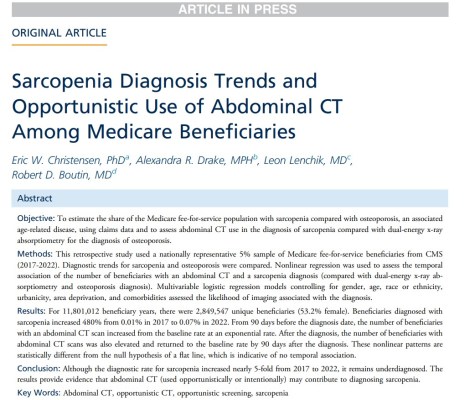The opinion manuscript discusses the challenges in estimating the pediatric radiology workforce and access to care in the U.S. It highlights the significant role of children’s hospitals in delivering specialized care but notes the geographic and workforce distribution disparities. The study finds that while children’s hospitals are essential, they are geographically concentrated, and pediatric radiologists are often spread thin, with many working remotely via teleradiology. Full Article
Tatiana Morales-Tisnés, MD, Casey E. Pelzl, MPH, Sarah S. Milla, MD, Hansel J. Otero, MD. 2025. "Current Challenges in Estimating the Pediatric Radiology Workforce and Access to Pediatric Radiology Care in the United States," Journal of the American College of Radiology (JACR)
April 17, 2025
A new Harvey L. Neiman Health Policy Institute study found evidence that a new diagnosis of sarcopenia, a potentially reversible disease with low muscle mass and strength, often coincides with an abdominal CT study. Increasing opportunistic evaluation of abdominal CT scans could facilitate diagnosis of sarcopenia and ultimately improve patient care. Read More
The objective of this study it to estimate the share of the Medicare fee-for-service population with sarcopenia compared with osteoporosis, an associated age-related disease, using claims data and to assess abdominal CT use in the diagnosis of sarcopenia compared with dual-energy x-ray absorptiometry for the diagnosis of osteoporosis Full Article
Eric W. Christensen, PhD, Alexandra R. Drake, MPH, Leon Lenchik, MD, Robert D. Boutin, MD. 2025. "Sarcopenia Diagnosis Trends and Opportunistic Use of Abdominal CT Among Medicare Beneficiaries," Journal of the American College of Radiology (JACR)
April 7, 2025
The Impact Report is a snapshot of what the Institute has accomplishing for ACR members and the patients they serve — advancing the specialty by meeting our members’ needs. Read More
April 2, 2025
A new Neiman Health Policy Institute study found that 43.6% of office-based imaging studies were interpreted by the ordering provider, with 58.5% interpreted within the ordering provider’s practice. Self-interpretation rates varied by specialty and imaging modality. Published in the AJR, the study analyzed over 1.6 million Medicare imaging claims from 2022. Read More






